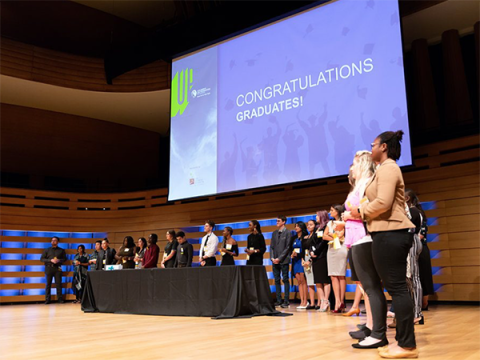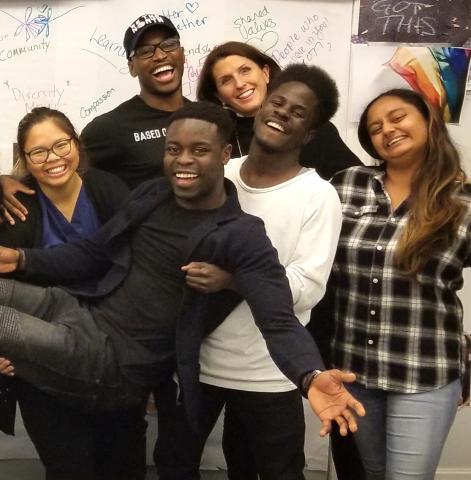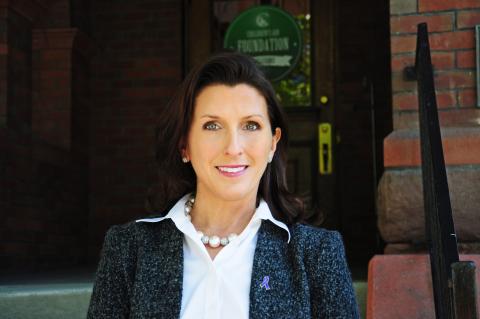
When the government is your parent, as Valerie McMurtry, president and CEO of the Children’s Aid Foundation of Canada, puts it in a nutshell, what happens to the kids that age out of the system, at 18, and have to fend for themselves? Higher education will undoubtedly open up doors to more opportunities but it’s an opportunity most people who have grown up in foster care can only dream about.
Children’s Aid Foundation of Canada was created by a group of philanthropists in 1979 as a local endowment fund in Toronto to help vulnerable children who were wards of the government. The Children’s Aid Society of Metropolitan Toronto Foundation, which became the Children’s Aid Foundation of Canada just two years ago, is “dedicated to improving the lives of children and youth in the child welfare system.”
The foundation raises and grants funds and develop programs that are delivered in partnership with 77 child and youth serving agencies across Canada. “We fill the gaps between what the government is able to provide and what vulnerable young people need to move confidently forward and create a bold vision of success for themselves,” it states on the web site.
Children’s Aid Foundation of Canada helps over 22,700 children and youth each year. One of the key components is educational support. Scholarships are awarded once a year through “a competitive process” overseen by the Foundation’s scholarship award committee. A further 20 scholarships are awarded through The Ted Rogers Scholarship Fund, which divvies up 150 scholarships between 14 organizations, including Children’s Aid.
Others are through individuals. One of the chief supporters is former Major League Baseball star Joe Carter, an American, yes, who hit the home run that won the Toronto Blue Jays the 1993 World Series. His annual Joe Carter Classic golf tournament has committed $1.67 million over the past 10 years to the Foundation, dispersed to post-secondary scholarships and to the Joe Carter Family Support Fund, which aims to strengthen at-risk families and communities in the Toronto area. Last month, Carter was back again in Toronto for his two-day event, featuring the tournament, Summit suite reception and Jays game, and a concert at Rebel by Salt-N-Pepa and Naughty by Nature.

Valerie McMurtry talked to Samaritanmag about the needs of the kids who age-out of the system and how the scholarship program works.
You’ve been with the Children’s Aid Foundation for more than five years, coming from CEO positions with the Canadian Olympic Foundation and prior to that Holland Bloorview Kids Rehabilitation Hospital Foundation. What in your background led you into the charity space and wanting to help others?
I had a business background before I came into this sector. I was good at it, but I didn't have a heart in it and I never really understood back in my early career that you can actually take great business skills and bring them to something you love and care about, like a great cause. I got into this through looking through the lens of kids who've had disadvantaged upbringings and that comes from my own family. My mother was a frontline social worker. We came from a really wonderful family and I was raised by great parents. I learned at an early age that not everyone had that. And so this cause, The Children's Aid Foundation, and kids in foster care and government care in this country, really resonates for me because these are children who have nobody advocating for them. They have a government as their parent.
How many kids are in foster care in Canada?
There are 237,000 kids. In every community in this country, there are kids who are experiencing or at immediate risk of experiencing abuse and neglect and abandonment. It's actually a big number for a country like this. And I think most people, if they think about it at all, think, ‘Well, that's what the government takes care of,’ and from a protection point of view, in terms of the risk of further danger, the government has that responsibility, but in terms of actually supporting young people to overcome their adversity and open doors for them to live a great life, that's where our foundation comes in.
The kids end up in foster care because they have been removed from the homes because of abuse?
Exactly. Or neglect. In Canada, it's a pretty legislated environment. Nobody can just go into someone's home and remove a child without just cause, and without a lot of regulation around it. The children who come in to permanent government care, where they've severed the relationship with the birth parents, it's because the parents have no capacity or they've done something illegal, like sexual abuse.
So what Children’s Aid Foundation does is raise money for extras?
Yes, It's a bit of both. We used to think about it that way, filling the gaps in the lives and we do some of that. But we think about it less that way and more around trying to drive towards better outcomes. We're a Foundation with great donors and great community support like Joe Carter. It's never going to be enough money to solve all of these issues. So we're trying to use the money that we raise to leverage other support and to advocate for some changes with the government.

We have three areas of interest. The area with Joe Carter and his event focuses on two things. We were talking about scholarships for youth who age out of care. In Canada, when kids turn 18, if they've been in foster care, they have to leave care; they're considered adults ,and anyone who's raised young children into adulthood, 18 — are you kidding me? No way they're ready to live on their own. The majority of these kids have not graduated from high school; only 46 percent. So this particular fund [Joe Carter’s] supports scholarships for postsecondary. We have a big national program for scholarships for youth aging out. We fund scholarships at $5,000 per year per student. Joe Carter, he gets our top picks.
The kids apply?
They apply and they have to go through a rating. There was a time when we had nearly enough money to fund everyone, which felt good because after you read about the challenges they've faced and the hard things that they shouldn't have had to encounter you just want to back every one of them for trying to get on with their lives. But today our program has grown so we don't actually have enough money to fund all of the students who apply. More and more are applying, which is good news. We have an arms-length committee who review all of our applications and they do a ranking. We have 12 members on our committee and they rank all of our students. This year, we have 230 students, and Joe Carter is going to fund three of those students [$5,000 each].
In an ideal world, how much money do you need on a yearly basis to fund all the applicants?
I think about that a lot. There's two parts to that question because we fund $5,000 per student and that helps a lot. If anyone's paid for their own school, they know that that's a good chunk, if it's approximately $20,000 to go to college or university for full-time for a year, especially because they have to pay for their own living costs. That's one of the other things you have to think about. Because kids who've left care don't have parents they can go home to in the summer so they pay their costs year-round.
So our funds help pay for all of their living expenses, but at $5,000 it only pays for a portion of it. Sometimes we think, ‘Wouldn't it be good to pick out some of the top top students and pay for everything?’ We haven't done that yet. Right now, everybody has $5,000. As I said, we're going to have 230 this year; I feel that if we could have a permanent fund for $2 million in a year — we're at about $1.5 million.
How much of your funding comes from corporate sponsors?
It’s mostly individuals on this program. We have other programs that get a lot of corporate support. We have some corporate support for this. But I love this program because it does attract people who are affluent, and when they write a cheque for $5,000 — it’s actually $5,500 because we charge for our administration — it's not a hardship. That is the primary source. For us, it's a great thing because it also introduces people who probably haven't known anything about the hardships that our young people face, and then they get the kind of first-line experience and they feel good for supporting an individual student.
It often leads, by the way, to other good things because the related piece is we hope most of them will get on the road to a really good job. Employment as the outcome. Getting an education is a huge part of that, but they also need to get jobs. They have other things to overcome, like not having a family and many of them have mental health challenges. But if we can connect more of the young people to good job opportunities and education, wow, that is feeling pretty good,
Can an individual sponsor a specific kid, get their name and put them through school?
Yes. We match the donor to a student. They get the bio and the profile of the student. They can meet them. We have an event that we hold every year in September [Stand Up for Kids Night, Sept. 11 in Toronto], where we give out the awards. Now because it’s national, it’s harder, but we do have a night where donors can meet their students at our reception and then we send an interim report during the school year to let the donor know how things have been going. And it's really honest. It's not always a bed of roses; they face a lot of challenges while they’re in school.
They can do that or if someone has an extra 200 bucks, it just goes into a pool?
That's right. We have bursaries and other sources of funds because we want to support as many young people as we can. They want to get on to the next stage of their life.
When you came to the Foundation as CEO and took a look at what they had accomplished and what more could be done, what were some of your goals?
The one big motivation I had was just to grow the organization because, again, it's not that well known. It was the opportunity to take what we've been doing in Toronto and making it bigger, national. So we became the Children's Aid Foundation of Canada not even two years ago, and now we're reaching more children in all parts because every community in this country needs to support them.
(Please support Samaritanmag's original journalism by making a PayPal contribution or EMT transfer using info@samaritanmag.com so we can increase the amount of content and writers we hire. Samaritanmag is the anti-tabloid, covering good people trying to change bad things. Let's make this thing bigger than TMZ.)
2020 air jordan 1 retro high og sail obsidian university blue 555088 140